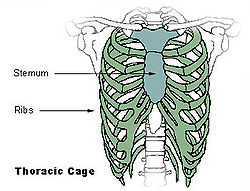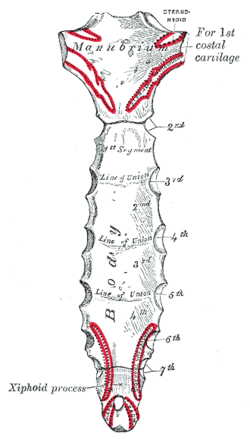Sternum
| Bone: Sternum | |
|---|---|
 |
|
| Thoracic cage | |
 |
|
| Posterior surface of sternum. | |
| Gray's | subject #27 119 |
| MeSH | Sternum |
The sternum (plural sterna or sternums, from Greek στέρνον,sternon, "chest" or breastbone) is a long flat bone (or, in some instances, set of three bones) shaped like a capital 'T' located in the center of the thorax (chest). It connects to the rib bones via cartilage, forming the anterior section of the rib cage with them, and thus helps to protect the lungs, heart and major blood vessels from physical trauma.
The sternum is sometimes cut open (a median sternotomy) to gain access to the thoracic contents when performing cardiothoracic surgery.
Contents |
Overview
The sternum is an elongated, flattened bone, forming the middle portion of the anterior wall of the thorax. Its upper end supports the clavicles (Collar bones), and its margins articulate with the cartilages of the first seven pairs of ribs. Its top is also connected to the Sternocleidomastoid muscle. It consists of three parts, from above downward:
- Manubrium
- Body of sternum (gladiolus)
- Xiphoid process
In its natural position, the inclination of the bone is oblique from above, downward and forward. It is slightly convex in front and concave behind; broad above, shaped like a "T", becoming narrowed at the point where the manubrium joins the body, after which it again widens a little to below the middle of the body, and then narrows to its lower extremity. Its average length in the adult is about 17 cm, and is rather longer in the male than in the female.
In early life its body is divided in three segments, called sternebrœ (singular: sternebra).
Structure
The sternum is composed of highly vascular tissue, covered by a thin layer of compact bone which is thickest in the manubrium between the articular facets for the clavicles.
Articulations
The sternum articulates on either side with the clavicle and upper seven costal cartilages.
Fractures of the sternum
Fractures of the sternum are rather uncommon. They may result from trauma, such as when a driver's chest is forced into the steering column of a car in a car accident. A fracture of the sternum is usually a comminuted fracture. The most common site of sternal fractures is at the sternal angle. Some studies reveal that repeated punches or continual beatings, sometimes called "sternum punches", to the sternum area have also caused fractured sternums. Those are known to have occurred in contact sports such as rugby and football. Sternum fractures are frequently associated with underlying injuries such as pulmonary contusions, or bruised lung tissue.[1]
In other animals
The sternum probably first evolved in early tetrapods as an extension of the pectoral girdle; it is not found in fish. In amphibians and reptiles it is typically a shield-shaped structure, often composed entirely of cartilage. It is absent in both turtles and snakes. In birds it is a relatively large bone and (except in ratites) bears an enormous projecting keel to which the flight muscles are attached.[2]
Only in mammals does the sternum take on the elongated, segmented form seen in humans. In some mammals, such as opossums, the individual segments, or sternebrae, never fuse and remain separated by cartilagenous plates throughout life.[2]
References
- ↑ Sattler S, Maier RV (2002). "Pulmonary contusion". In Karmy-Jones R, Nathens A, Stern EJ. Thoracic Trauma and Critical Care. Berlin: Springer. pp. 235–243. ISBN 1-4020-7215-5. http://books.google.com/books?id=zSge9BxBCd0C&pg=PA235&dq=%22pulmonary+contusion%22&lr=&sig=uGqtmdp1-4Rg6zbN2W3gTE_aszU#PPA235,M1. Retrieved 2008-04-21.
- ↑ 2.0 2.1 Romer, Alfred Sherwood; Parsons, Thomas S. (1977). The Vertebrate Body. Philadelphia, PA: Holt-Saunders International. p. 188. ISBN 0-03-910284-X.
This article was originally based on an entry from a public domain edition of Gray's Anatomy. As such, some of the information contained within it may be outdated.
See also
- Ossification of sternum
- Bone terminology
- Terms for anatomical location
- Pectus carinatum
- Pectus excavatum
|
||||||||||||||||||||||||||||||||||||||